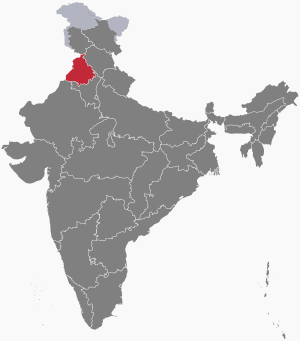Operation Woodrose
Operation Woodrose was a military operation carried out by the Indira Gandhi-led Indian government in the months after Operation Blue Star to "prevent the outbreak of widespread public protest" in the state of Punjab.[3] The government arrested all prominent members of the largest Sikh political party, the Akali Dal, and banned the All India Sikh Students Federation, a large students' union.[3] In addition, the Indian Army conducted operations in the countryside during which thousands of Sikhs, overwhelmingly young men, were detained for interrogation and subsequently tortured.[3] Despite its purported success in controlling the armed insurgency in the Punjab region, the operation was criticized by human-rights groups for the suspension of civil liberties and habeas corpus, resulting in the disappearances of thousands of Sikh men. After the operation, the central government was criticized for using "draconian legislation" to repress a minority community.[3]
| Operation Woodrose | |||||||
|---|---|---|---|---|---|---|---|
| Part of Punjab Insurgency | |||||||
 Shown in red is the state of Punjab | |||||||
| |||||||
| Belligerents | |||||||
|
|
[Sikhs of Punjab region] | ||||||
| Casualties and losses | |||||||
|
| Unknown; no official count done | ||||||
| over 12,000 civilian deaths in total insurgency[2] | |||||||
Conduct of the operation
The operation consisted of the rounding up of thousands of Sikh youth, including several presumably innocent civilians. According to estimates published by Inderjit Singh Jaijee, approximately 1 million individuals were reported as missing or killed as a result of Army operations during this period.[4] According to Dr.Sangat Singh, Joint Intelligence Committee, about 100,000 youth had been taken into custody within first four to six weeks of the operation and he adds that many of them were not heard of again.[5] He further adds about 20,000 youth crossing over to Pakistan.[5]
Punjab-Chandigarh Disturbed Area Act (1983) and other measures
To allow for the legality of the operation, the states of Punjab and Chandigarh had been declared by the Indian government as 'disturbed areas' by the enactment of the Punjab Chandigarh Disturbed Area Act 1983,[6] while the Army was given unprecedented powers to detain and arrest civilians by the enactment of the Armed Forces (Punjab and Chandigarh) Act 1983.[7] The act empowered any commissioned, warrant or non-commissioned officer of the Army if "of opinion that it is necessary so to do for the maintenance of public order, after giving such due warning as he may consider necessary, fire upon or otherwise use forces, even to the causing of death". The act also allowed such an officer to "arrest, without warrant, any person who has committed a cognizable offence or against whom a reasonable suspicion exists that he has committed or is about to commit a cognizable offence".
Fast Track courts were set up under the Terrorist Affected Areas (Special Courts) Act 1984 [8] to try to sentence suspected terrorists rapidly.[9]
Outcome
Punjab Chief of Police, Kanwar Pal Singh Gill described the actions as "suffering from all the classical defects of army intervention in civil strife" and stated that the Indian Army had acted "blindly".[10]
The army operations were overseen by Major General Jagdish Singh Jamwal, who was assigned the responsibility to seal the international border with Pakistan, in an attempt to control smuggling of arms and personnel, and by Lieutenant General Ranjit Singh Dyal, who was instructed to oversee the apprehension of militants in state of Punjab.[11]
References
- Gates, Scott; Roy, Kaushik (17 February 2016). Unconventional Warfare in South Asia: Shadow Warriors and Counterinsurgency. ISBN 9781317005414.
- Punjab militancy: There have been 12,000 deaths. One India.
- Deol, Harnik (2000). Religion and nationalism in India: the case of the Punjab. Psychology Press. pp. 108–109. ISBN 978-0-415-20108-7. Retrieved 22 July 2011.
- Jaijee, Inderjit Singh (1995). Politics of genocide: Punjab, 1984-1994. The University of Michigan. p. 216.
- Sangat Singh, Sikhs in history, page 384
- THE CHANDIGARH DISTURBED AREAS ACT, 1983 : Legal India :: Legal India : Law Information Portal of India
- [The] Armed Forces (Punjab And Chandigarh)
- Terrorist Affected Areas (Special Courts) Act 1984
- Darshi, A R (1999). The gallant defender. Sikh Students Federation. p. 108. ISBN 81-7601-468-0.
- Art, Robert J. (2007). Democracy and counterterrorism: lessons from the past. United States Institute of Peace. p. 441. ISBN 978-1-929223-93-0.
- Jaijee, Inderjit Singh (1999). Politics of genocide: Punjab, 1984-1998. Ajanta Publications. p. 72. ISBN 978-81-202-0415-7.